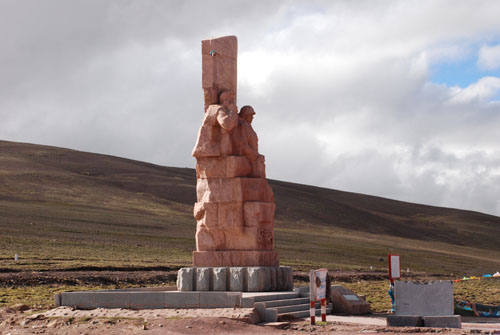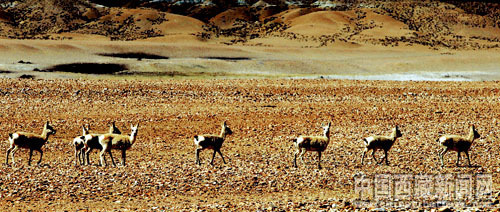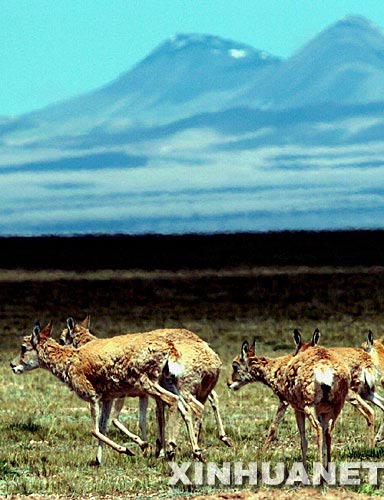
The pass of Tanggula Mountain.


Tibetan antelopes.
Dubbed as highland eidolon, Tibetan antelopes start their trek of migration in groups every June. Going over mountains and passing rivers, they create a magnificent fascination of nature and live up the icy snowy highland. Everything nice has to stop when illegal poaching was rampant. High profit entices many poachers into hunting the Tibetan antelopes. With voice screaming for protect Tibetan antelopes, more volunteers are reaching the no-man areas to offer help while laws were carried out to prevent from illegal hunting of Tibetan antelopes.
With efforts taken, we are wondering if now Tibetan antelopes are living safely and peacefully……Following the steps of a group of journalists who are heading for Amdo of Tibet, we got the answer.
Anti-poaching patrolling in no-man areas
Aqiong, head of the Forestry Bureau of Amdo, knows very well about Tibetan antelopes. He said there are about 2,000 to 3,000 Tibetan antelopes scattering in Sewu, Maqu, Gangnyi, Zhaqu, Doima villages and Qangma Township within Amdo. In 1993, the forestry police station was set up to patrolling around the dense areas of Tibetan antelopes with 34 wild animals guarder at hand. Since then, anti-poaching armed patrol became an important action to protect Tibetan antelopes and also a key job for Aqiong himself.
In a chilly day of December 2005, Aqiong led a four-member group to the remote Sewu Village. Sewu Village lies in the Changtang Nature Reserve and a large part of its territory are unmanned. With two cars, one for man and one for their daily necessity and food, their hard patrolling started. It is really shivery in December. Roads became bumpy when they were running away from the Qinghai-Tibet Railway and they had to ride in unpaved roads. The cars were trudging in the snow and ice covered roads. Howbeit, things didn't go as they hope. They were forced to push the car in river water with 40 degrees below zero centigrade when the car was acted up and can not move forward. Just in a short time, the truck was sack in mud and it took them several hours to get rid of it. It never rains but pours. In the 7th day of their journey, the tire of one of the car burst. They have to spend the night in wild against the bitter cold.
The hardest time comes in the night. There is no drinking water and they had to smash ice to suck water from it. Sometimes, they also drank salt water when fresh water is unreachable. They used yak dung to make fire, which caused a niff, ate Zanba twice a day and slept in cold tents. …..
It is a hard work and almost impossible for the group to reach every corner of the village because of wide territory. It took the group almost one month to finish the patrolling.
"We arrange one to two patrols like this every year. Ever since 2000, we have organized 37 patrols, involving 191 person-times and 64 cars, costing a total of 287 days with a working coverage of 50,074 kilometers, "said Aqiong with smile.
Anti-poaching campaign of Tibetan antelopes
The Changtang Grassland of northern Tibet is one of the main habitats of Tibetan antelopes. It looks even more beautiful because of the existence of Tibetan antelopes, contrarily, it also becomes a frequently occurred region of illegal poaching and a concentrated area of poachers.
According to Lhasa Customs Smuggling Suppressing Bureau, contraband of Tibetan antelopes reached the climax in 1990s. From 1996 to 1997, a total of 843.85 kilogram Tibetan antelope pashm were seized by Nylam and Shiquanhe customs of Lhasa. Experts analyze an adult Tibetan antelope can produce only 2 liang (one liang equals to 31.25 gram) of pashm so we can imagine how many Tibetan antelopes were killed to pile up such a big sum of pashm!
To protect Tibetan antelopes, Tibet Autonomous Region has been exerting great efforts to crack down illegal hunting. From 1993 to 2003, 364 cases of hunting Tibetan antelopes were handled, putting 18 illegal poachers put into jail.
For the good of Tibetan antelopes
Tibet is the main habitat of Tibetan antelopes. They mainly live in Changtang of Tibet with a territory of more than 600,000 square kilometers. Since 1990s, a large part of habitats for Tibetan antelopes in Changtang areas were listed into nature reserves, forming thebiggest nature reserve for terraneous wild animals in the world. In 2002, the Changtang Nature Reserve was inscribed into a state level one, playing an even important role in protection of Tibetan antelopes.
Organizations, stations and bureaus at different levels, have been respectively set up in those Tibetan antelope inhabited areas to monitor, take care and protect Tibetan antelopes since the end of 1990s.
According to Drolam Yangdzom, head of the wild animals protection office of Tibet Forestry Bureau, Tibet has been invested more than 60 million yuan to assist the work of protection Tibetan antelopes, from buying equipment, paying salary to patrol expense. By far, there are 300 to 400 people working for the Tibetan antelopes.
The world-focused Qinghai-Tibet Railway passes by the living areas of Tibetan antelopes, but does not bring influence or harm to their migration, propagation and living. The largest Tibetan antelope littering area in Tibet was currently found in the north Sewu snowy mountain in Sewu Village within the Changtang Nature Reserve.
As reported, the account of Tibetan antelopes here has increased from 10,000 in 2000 to current some 120,000 and the total number of Tibetan antelopes in Tibet has reached more than 150,000, with a yearly increase of 7.9 per cent.
We have reason to believe that the Tibetan antelope will happily be able to live in a more peaceful and safe environment under the supports of all government concerned and the public.
